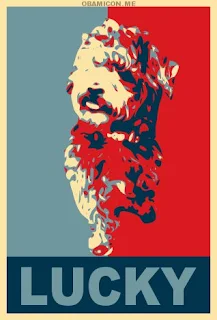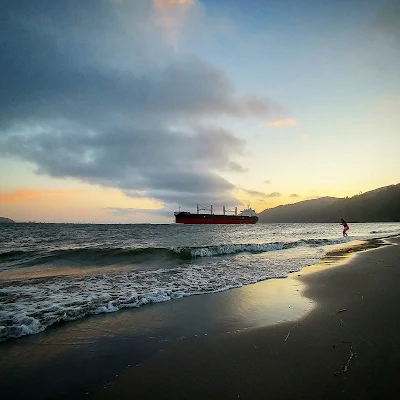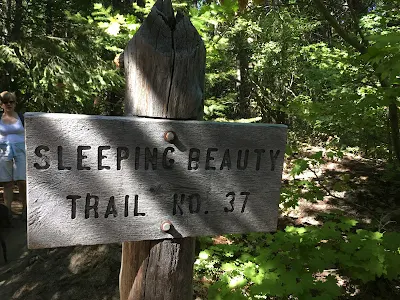“Dogs’ lives are too short. Their only fault, really.” – Agnes Sligh Turnbull
Sometimes I worry about Lucky.
He sleeps late. He needs help coming down stairs, he doesn’t eat, spends the day curled up on the couch by the window, only occasionally looking outside at the rain.
Yet other days he is up early, eats a big breakfast and runs around the house with boundless energy, he goes for long walks out in the fields even in the pouring rain.
Why waste a good day if only the weather is bad.
He does well for an old dog.
As far as we can tell, Lucky is 14 years old -- the first few years before we adopted him from Must Love Dogs NW were eventful.
The story we were told was that he was hit by a car and lost an eye. Without the eye, he failed to see a train coming and lost a leg and his tail.
Three legs, one eye and no tail -- I like to say he’s only three-quarters dog.
We were also told that he was a street dog in Thailand, brought back to US by a Veterinarian who met him on a medical mission trip. As one of the millions of so-called “soi dogs” he belonged to no one. This myth of him starting life half a world away is such a bizarre origin story that is must be true. Moreover, it fits with his personality.
Like that Margaret Wise Brown book “Mr Dog”, Lucky doesn’t belong to us. He is the dog that
belongs to himself. When he was younger, he would just hop in any car that happened to be passing by. He is happy to follow a stranger home if they smell good and might offer him food.
No, we have never owned Lucky. Yet he has always owned the heart of my younger daughter Grace. Grace was just 4 years old when we got him and she was obsessed with him from the start. Her kindergarten teacher commented that he was all she ever talked about or drew pictures of. Over the years Grace and Lucky have appeared in so many pictures together that the Facebook algorithm automatically tags pictures of Grace as Lucky Hunt. They are, as best we can tell, the same age. Although her 14 years would be 98 years to him. They have spent a decade together.
She growing up, he growing old.
They have grown so close, I fear the day when he is no longer.
Yet Lucky is a tough one. Untroubled by the injuries early in his life he has always managed to run, jump and play. His left hind leg didn’t heal right and only has two toes. On hard surfaces he just lifts that bad leg and runs on the two right legs. As old as he is, on a good day he can still move pretty fast when he wants to. He still feels it is his job to protect his house.
When I am 98, I hope I am still able to walk out in the fields on rainy mornings, marking my territory so the coyotes don’t dare come near.
Lucky was never much interested in other dogs. He prefers to keep company with cats. We don’t judge. That’s just how God made him. He loves playing with cats -- and would often wrestle with them in his younger days. A few years ago, we picked out two siamese kittens from a neighbor and Lucky promptly adopted them, letting them sleep in his bed and knead his fur. Today the cats are full grown and almost bigger than he his. Yet, he’ll still grooms them when they come in from the rain.
The only dog I’ve ever seen him play with is Wendy.
Wendy is a yellow lab. She was just a puppy when she was given to my mom.
Somehow, she latched on to me and decided that I was her favorite person. When I would come to visit, I’d get her undivided attention. Once the girls went down to The Dalles to visit mom while I was working and Wendy sat staring at the door waiting for me to come in.
When mom retired to the beach, Wendy moved out to the farm to live with us and thrived in her farm-dog years. She sits on the porch and alerts us to anyone who comes down the driveway, and helps me work on the motorcycles by licking my face whenever I get near the ground. She is a great outfielder when we play catch. She loves chasing the dirt bikes out the field and walks by the river.
I assumed that Labs all were born knowing how to swim. One time out on the farm I threw a stick out in the water and Wendy hesitantly jumped in - and sunk like a stone. She didn’t bob up dog paddling either. Instead she thrashed and staggered up on the riverbank, looking back at the water in horrified betrayal.
So I had to teach her to swim down at the Covered bridge.
Lucky can swim -- although with the one front leg he tends to list to the left. While I was giving Wendy lessons, Lucky spotted a critter darting into a hole on the opposite riverbank. He took off across the water after whatever-it-was and clambered up the bank and into the hole.
Whatever-it-was apparently wasn’t accepting visitors. Lucky came right back out, stranded crying on the river bank. With one eye, he lacks depth perception--getting down from places is tricky. So, I had to wade across to rescue him. Wendy eagerly thought she’d help, but halfway across panicked and tried to drown me. The girls got a great laugh watching this whole fiasco.
Wendy’s getting older now too. She is not much younger than Lucky. She still has that lab-puppy smile but she moves at a walk instead of a run when playing fetch most days.
We all get older. Both humans and dogs are born with expiration dates printed somewhere in the weaving of our fates. As the years pile on, we all have good days and bad.
It is the tragedy of our existence that dogs get older at a faster pace than we humans. Thus inevitably, the ever-constant love of a dog must one day become a memory.
Yet the mark they leave in our hearts is indelible all the same.
I struggle to write anything profound about dogs that hasn’t already been written. Dog wisdom has becomes its own literary genre of late. No surprise since we have had dogs at our side since the earliest campfires of our humanity. Scientists believe that we co-evolved with dogs starting about 100,000 years ago. A good part of our evolutionary success is due to dogs watching over us at night and helping us on the hunt. Over the eons they have learned to anticipate what we want and need. They have warmed us, warned us and helped us become who we are.
Along the way, dogs have distilled the emotion of love into its purest form.
Older dogs like Wendy and Lucky still have much companionship to give. People often look for puppies when they want a dog, but senior dogs can be more social, calm and easier to adapt to your family. They are usually already house trained and less likely to chew up your shoes.
Yet, no matter how old a dog gets, the well of their love never runs dry.
-30-












































